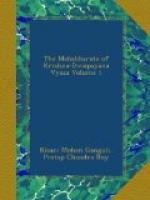The generation of Devas, in brief, was thirty-three thousand, thirty-three hundred and thirty-three. The sons of Div were Brihadbhanu, Chakshus, Atma Vibhavasu, Savita, Richika, Arka, Bhanu, Asavaha, and Ravi. Of these Vivaswans of old, Mahya was the youngest whose son was Deva-vrata. The latter had for his son, Su-vrata who, we learn, had three sons,—Dasa-jyoti, Sata-jyoti, and Sahasra-jyoti, each of them producing numerous offspring. The illustrious Dasa-jyoti had ten thousand, Sata-jyoti ten times that number, and Sahasra-jyoti ten times the number of Sata-jyoti’s offspring. From these are descended the family of the Kurus, of the Yadus, and of Bharata; the family of Yayati and of Ikshwaku; also of all the Rajarshis. Numerous also were the generations produced, and very abundant were the creatures and their places of abode. The mystery which is threefold—the Vedas, Yoga, and Vijnana Dharma, Artha, and Kama—also various books upon the subject of Dharma, Artha, and Kama; also rules for the conduct of mankind; also histories and discourses with various srutis; all of which having been seen by the Rishi Vyasa are here in due order mentioned as a specimen of the book.
The Rishi Vyasa published this mass of knowledge in both a detailed and an abridged form. It is the wish of the learned in the world to possess the details and the abridgement. Some read the Bharata beginning with the initial mantra (invocation), others with the story of Astika, others with Uparichara, while some Brahmanas study the whole. Men of learning display their various knowledge of the institutes in commenting on the composition. Some are skilful in explaining it, while others, in remembering its contents.
The son of Satyavati having, by penance and meditation, analysed the eternal Veda, afterwards composed this holy history, when that learned Brahmarshi of strict vows, the noble Dwaipayana Vyasa, offspring of Parasara, had finished this greatest of narrations, he began to consider how he might teach it to his disciples. And the possessor of the six attributes, Brahma, the world’s preceptor, knowing of the anxiety of the Rishi Dwaipayana, came in person to the place where the latter was, for gratifying the saint, and benefiting the people. And when Vyasa, surrounded by all the tribes of Munis, saw him, he was surprised; and, standing with joined palms, he bowed and ordered a seat to be brought. And Vyasa having gone round him who is called Hiranyagarbha seated on that distinguished seat stood near it; and being commanded by Brahma Parameshthi, he sat down near the seat, full of affection and smiling in joy. Then the greatly glorious Vyasa, addressing Brahma Parameshthi, said, “O divine Brahma, by me a poem hath been composed which is greatly respected. The mystery of the Veda, and what other subjects have been explained by me; the various rituals of the Upanishads with the Angas; the compilation of the Puranas and history formed by




